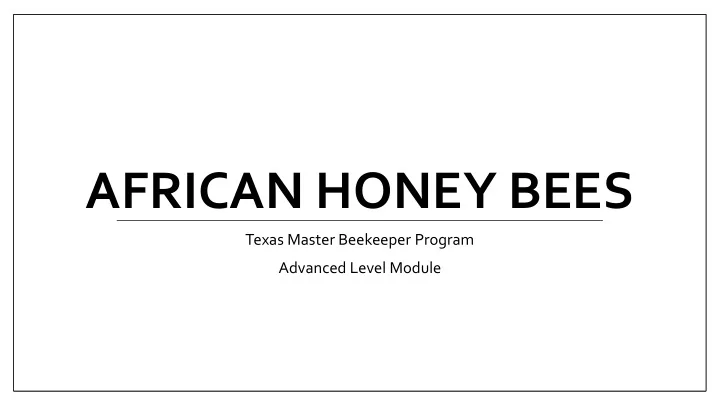

AFRICAN HONEY BEES Texas Master Beekeeper Program Advanced Level Module
European vs. African • Both types of honey bees belong to the genus Apis . • Recognized honey bee is the western honey bee, Apis mellifera . • North America has 5 European subspecies • African honey bee: Apis mellifera scutellata
Africanized Honey Bees • Hybrid between African and European honey bees • Commonly used acronym: AHB • African honey bee genetics have been diluted due to: • Large population of European honey bees • Beekeeping industry and feral colonies • AHB genetics can result in unpredictable behavioral traits • More defensive than European honey bees • Be aware and be safe! Photograph by W. H. Kern, University of Florida
African vs. Africanized • African honey bees = pure race of honey bees in Africa • Africanized honey bees = hybrid between European and African honey bees • Feral honey bee colonies in Texas have a high possibility of containing African genetics. • Can only be confirmed through morphometric or genetic testing
How can you tell the difference? • Visual inspection cannot confirm whether a honey bee is European or Africanized • Laboratory testing is required to differentiate between the two. • Fast African Bee Identification System (FABIS) • Morphometric test • Identifies AHB in a lab • Florida is the only state that accepts samples from the public. • If FABIS cannot give a clear identification, then USDA-ID (Universal System for the Detection of African honey bees) is used. • More comprehensive morphometric test.
AHB – General Precautions • Be aware of any bee activity in the area. • Examine your surroundings before using loud machinery. • Do not disturb a swarm/colony if one is discovered • Make sure to have an EpiPen on hand if you or a family member are allergic to honey bee stings.
AHB –What do you do if… 1) You find a swarm/colony • Do not disturb the bees or attempt to remove them. • Do not spray the bees • Contact a beekeeper or pest control operator to remove or eradicate the swarm/colony 2) If the bees become defensive • Run away! And in a straight line. • Protect your face as you run. • Get into an enclosed area and stay there! • Do not jump into water or hide in bushes. • Do not swat at the bees. • Call 911
AHB –What do you do if… 3) If someone gets stung • Remove the stinger as soon as possible! • Wash the affected area with soap and water • apply ice to minimize swelling • Seek medical attention if: • A severe allergic reaction occurs (trouble breathing, hives covering large portions of body) • Stung many times (5-10 stings/pound of body weight venom overdose)
Bee-Proofing for Texas Citizens • AHB can nest almost anywhere • EHB need an enclosed space • AHB can build nests in exposed areas • Most insect problems have an easy fix, not the case with AHBs • They can create dangerous situations for children, the elderly, and pets in the surrounding area. • Bee-proof your property! • Prevent/remove AHB nesting sites • Possibility of stinging incidents decrease Credit: Bob Cymbolin • Saves money- bee removals can be expensive • Constantly inspect area to make sure it stays proofed
Locating Potential Nesting Sites • Identify areas that are choice sites for swarms to inhabit • Attractive sites: • Small opening to an open, shaded area • Ex: water meters, holes in exterior wall, pipes, etc.
Potential Nesting Sites • Some areas may be difficult to bee-proof • Ex: under eaves, under a house/shed, cement blocks, recesses in a roof • Regularly inspect these areas
Other Potential Nesting Sites • Signs, tree hollows, playground equipment, empty containers, old tires, chimneys
How to Prevent Nests from Forming • Screening • Use 1/8” hardware cloth or standard insect screen • Staple or attach over access hole • Method best used to close off vents, drains, etc. • Screen allows air/water to pass through while preventing bees from entering • Caulking • Use 100% silicone caulking • Seal cracks, crevices, or other voids that are 1/8” or greater in width • To seal cracks/crevices in concrete surfaces, use latex concrete-crack filler
How to Prevent Nests from Forming • Foam • Use expanding/insulating foam sealant for holes or cracks in a wall. • Paint over the surface to prevent foam from eroding due to weathering. • Filler • Wood filler/concrete patching can also seal up walls if caulk or foam cannot be used. • Tape • Duct tape can seal holes in water meter covers or other small holes
Inspecting Your Property • It’s difficult to bee-proof every possible nesting site, but it is important to regularly check the property for bee activity. • Swarm season is between March and July (although it could be longer in certain parts of Texas) • It is important to be extra vigilant during this time of year. • Do not seal a hole in a wall if bees are seen coming and going • Sealing the hole will cause the bees to go further into the wall/structure • Remove the colony first before sealing the opening • If you do discover a colony or swarm, contact a beekeeper or a pest control operator. • For a list of beekeepers, please visit the Texas Apiary Inspection Service website (txbeeinspection.tamu.edu)
Recommend
More recommend